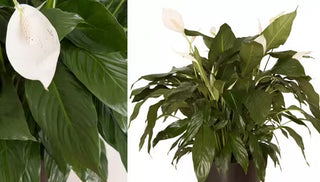One of the few popular houseplants actually known for its flowers, the Peace Lily (Spathiphyllum spp.), is cherished for its elegant, white blooms, which resemble a white flag of peace. Hailing from tropical regions of Central and South America, the Peace Lily is not a true lily, but a member of the Araceae family, which also includes the philodendron and anthurium. A NASA air study found that Spathiphyllum cleans indoor air of certain environmental pollutants, including carcinogenic benzene and formaldehyde. Its graceful appearance and air-purifying qualities make it a beloved addition to homes and offices!
Popular Cultivars or Varieties of Peace Lily
While the classic Peace Lily (Spathiphyllum wallisii) is the most common variety, there are other dozens of other cultivars to try:
Spathiphyllum wallisii ‘Domino’: showcases marbled green and white leaves
Spathiphyllum wallisii ‘Sensation’: the tallest Peace Lily, it boasts huge, deeply ribbed leaves
Spathiphyllum wallisii ‘Golden Delicious’: a newer cultivar, it has yellow-green foliage
Best Growing Conditions for Peace Lily
Light
Peace Lilies thrive in medium to low indirect light. Avoid placing them in direct sunlight, as it can scorch their leaves. They can be a perfect fit for areas with lower light conditions in your home or office.
Soil
Peace Lilies prefer a potting mix that mimics their native forest floor soil: rich, slightly acidic, and well-drained. A mix of peat moss, perlite, and bark ensures good aeration and fertility.
Humidity
As a tropical plant, Peace Lilies appreciate higher humidity levels. Regular misting, using a humidifier, or placing the plant in a steamy bathroom can help increase humidity around the plant.
How To Care for Peace Lily
Watering
Peace Lilies prefer evenly moist, but not waterlogged, soil. Water thoroughly and allow the top inch of soil to dry out slightly between waterings. Overwatering can lead to root rot, so it's essential to strike a balance.
Fertilizing
Feed Peace Lilies with a balanced, water-soluble fertilizer diluted to half-strength every 6-8 weeks during the growing season (spring and summer). Reduce or stop fertilization during the dormant season (fall and winter).
Pruning
Pruning is minimal for Peace Lilies. Trim yellow or brown leaves at their base using clean scissors or pruning shears to maintain the plant's appearance.
Propagating
Propagating Peace Lilies is possible through division. Carefully separate the plant into smaller sections and pot them individually in fresh soil.
Peace Lily Pests and Problems
Identifying and Controlling Pests
Common pests for Peace Lilies include spider mites, aphids, and mealybugs. Wipe leaves with a damp cloth or use insecticidal soap to control infestations.
Common Signs of Stress and Treatment
Signs of stress in Peace Lilies include drooping leaves, yellowing, or wilting.
Wilting or drooping leaves
This can indicate underwatering or low humidity. The plant should be watered thoroughly and misted regularly until it recovers.
Yellowing leaves
Older leaves will naturally turn yellow as they age; you can prune these leaves or allow them to drop on their own. If new leaves are turning yellow, this can indicate overwatering. Reduce the watering frequency and check the plant for root rot.
Peace Lily FAQs
Q: Can Peace Lilies bloom all year round?
A: Peace Lilies typically bloom in cycles, often producing flowers in the spring and autumn if provided with proper care. If your Peace Lily is not blooming, it likely isn’t receiving enough light or nutrients. Try moving the plant to a brighter location or feeding it with a high-phosphorous fertilizer.
Q: Is the Peace Lily toxic to pets?
A: Yes, Peace Lilies are mildly toxic to cats and dogs. Keep them out of reach or display them in areas inaccessible to pets.
Q: Why are the leaves on my Peace Lily drooping?
A: Peace Lilies thrive when kept consistently and evenly watered — if underwatered, they are quick to droop and wilt. Don’t panic; if watered promptly, they will perk up quickly!
Peace lilies are relatively low maintenance, and as their name suggests, bring a tranquil and soothing vibe to the indoor garden. Serenity now!




